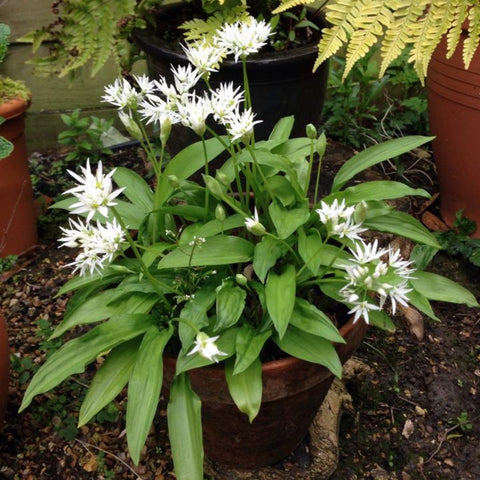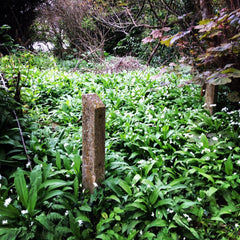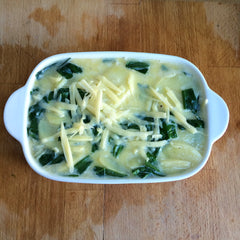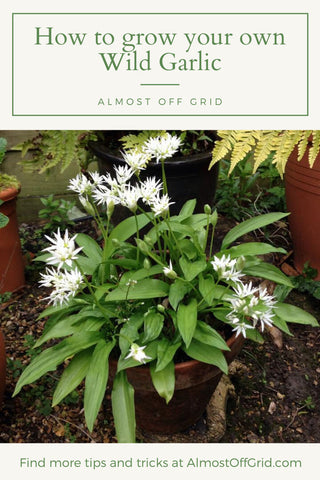Grow your own Wild Garlic
Spotting wild garlic on country walks is wonderful. You usually smell it before you see it, and it tells you that Spring is either here or on its way. Depending on where you live though, you may struggle to find some. So why not Grow your own Wild Garlic instead? Wild garlic is easily grown from wild garlic bulbs. The ideal time to plant it is from October to mid March, so there is still time to get yours going.

Growing your own Wild Garlic
We grew our first Wild Garlic about 3 years ago. You will find Wild Garlic bulbs to buy on Ebay at this time of year, which is where we bought ours.
Please don't consider taking bulbs from the wild and planting them in your garden. Once the bulb is dug up, the garlic won't come back next year from wherever you took it. And besides, unless you have landowner’s consent, it is illegal.
The plant can be highly invasive, so we decided a pot was the way to go. Having too much wild garlic sounds doesn't really sound like a problem at all when you don't have any. But there was a reason we did it this way. My father's front garden is overrun with wild garlic. Every Spring you can smell it well before you reach it. Lovely to visit, not sure I'd want to live with that overpowering smell every time I opened the windows. Hence we started ours off in a pot. Then we decided to pop it in the ground at our allotment. The bulbs reproduce quickly and we're looking forward to another great harvest this year.
How to Grow It
Wild garlic is easily grown from wild garlic bulbs. The ideal time to plant it is from October to early March, so there is still time to get yours going. When your bulbs arrive in the post they may look pretty uninspiring. Just pop them directly into the earth outside. Wild garlic thrives best in slightly acidic soil and in moist conditions. It certainly doesn't mind a bit of shade either.
Foraging - How to Identify Wild Garlic
 The smell of wild garlic is, of course, unmistakable. But unless you happen upon an enormous patch of it, you may not smell it. We're lucky enough to have masses of it nearby on The Cuckoo Trail in vast amounts, walking distance from where we live.Lush green Wild Garlic stems look like a lot of other leafy Spring vegetation, not all of which is safe to eat. So you need to be cautious if you're collecting it in the wild. It can easily be mistaken for lily of the valley, lords and ladies or autumn crocus, all of which are toxic and will land you in hospital or worse.
The smell of wild garlic is, of course, unmistakable. But unless you happen upon an enormous patch of it, you may not smell it. We're lucky enough to have masses of it nearby on The Cuckoo Trail in vast amounts, walking distance from where we live.Lush green Wild Garlic stems look like a lot of other leafy Spring vegetation, not all of which is safe to eat. So you need to be cautious if you're collecting it in the wild. It can easily be mistaken for lily of the valley, lords and ladies or autumn crocus, all of which are toxic and will land you in hospital or worse.
If you pick a leaf, crush it gently in your hand and it smells of garlic: it's wild garlic. In the years before we knew what it looked like we used to wait until the beautiful white flower clusters appeared to be absolutely sure we had the right plant. But flowers don't appear until the end of March at the earliest, often more like April. By then the leaves have got bigger and are a bit less tender to eat. But of course if you grow your own, you already know you have the right plant and that it's safe to eat.
How to Harvest Wild Garlic
Harvest Wild Garlic leaves, flowers and stems using scissors, being careful not to damage them as you cut them - they bruise easily. Wild garlic will wilt quickly after picking. So if you're not going to eat it straight away, pop it in a sealed bag in the fridge with a few drops of water. It should keep for a couple of days.
Cooking with Wild Garlic
Wild Garlic is a member of the Allium family, much like leeks, onions, spring onions and our more familiar bulb garlic. And like all of those vegetables, it is more pleasant to eat cooked than raw. You can use Wild Garlic in any recipe where you would use regular garlic, though bear in mind it's a lot milder than standard garlic.
The leaves, flowers and stems are all edible. They're great for Wild Garlic Pesto, popping in garlic butter or in egg-based dishes like frittatas and omelettes. The flowers and tender young leaves, used sparingly, are very pretty in a salad.
 You can freeze it too. The leaves don't look so great when they defrost - a bit like defrosted lettuce. But defrosted Wild Garlic is perfect for adding to dishes where looks don't matter. Like Wild Garlic Pesto. I have also been known to make a mean Dauphinoise Potatoes with Wild Garlic. Absolutely delicious.
You can freeze it too. The leaves don't look so great when they defrost - a bit like defrosted lettuce. But defrosted Wild Garlic is perfect for adding to dishes where looks don't matter. Like Wild Garlic Pesto. I have also been known to make a mean Dauphinoise Potatoes with Wild Garlic. Absolutely delicious.
My posts usually contain links to our webshop and/or affiliate links to other shops. If you click on them, I may receive a commission at no extra cost to you. Find our disclosure policy here.


I picked some wild garlic for pesto & found some pods within the leaves which must have been pre-flower pods. I have kept them & am drying them. Could I use the seeds inside to sow a new crop in my veg garden & then transplant into woodland? thanks.
Hi David, I wouldn’t freeze them because I think that would probably kill them. I would treat them like I do daffodil bulbs in pots which I intend to plant on the allotment once they finish flowering: I leave them dormant in a pot of earth and then transplant the whole thing when I’m ready to plant. You can start planting wild garlic from October-time. Good luck!
how can preserve the bulbs I’ve picked till Oct. when I’m ready to plant them?
is it possible to freeze then
Hi Benedict, thanks for this. Yes you can save the wild garlic seeds and plant them indoors from March-time, in pots like you would any other seedlings and then outside once they’re a decent size. Alternatively you can sow the seeds directly outside from April/May. I would start them inside though, reason being that wild garlic germinates at a temperature of 15°C to 20°C and you’re more likely to hit that temperature indoors than outside in April (depending on where you live). Bulbs can be a quicker route to having a crop in your first year than seeds, because you can plant bulbs in October and they’ll come up as soon as the weather is mild. And once you have a patch, even if it’s only small, they sort of take on a life of their own (translate as ‘can be invasive if you’re not careful’). My Dad has masses in his garden, it’s everywhere and he’s done nothing to encourage it. Luckily he likes it!
Can you wait for the flowers to die back into seeds and then sow the seeds? is this not easier than bulbs?